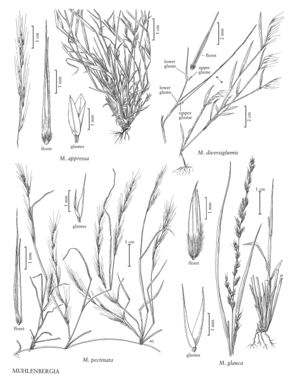Muhlenbergia pectinata
Plants annual. Culms 10-33 cm, erect or decumbent, sometimes rooting at the lower nodes; internodes glabrous. Sheaths usually longer than the internodes, glabrous, margins sparsely hairy distally, hairs to 1 mm, coarse; ligules 0.3-0.9 mm, membranous, truncate, ciliate; blades 1-6 cm long, 0.6-2 mm wide, flat to loosely involute, appressed-pubescent to sparsely pilose. Panicles 4-12 cm long, 0.5-2.6 (4) cm wide; primary branches 2-3.5 cm, appressed or diverging up to 70° from the rachises; pedicels 1-3 mm, glabrous, appressed; disarticulation above the glumes. Spikelets 2.5-5 mm, borne singly. Glumes glabrous, 1-veined, acute to acuminate, unawned or awned, awns to 1.5 mm; lower glumes 0.8-1.7 mm, entire; upper glumes 1-2 (3) mm; lemmas (2.5) 3-4.5 (5) mm, subulate to lanceolate, calluses appressed-pubescent, lemma bodies appearing 5-veined (the intermediate veins actually rows of short barbs on top of folded epidermal ridges), lateral-veins occasionally ciliate, apices acuminate, awned, awns 10-32 mm, slender, flexuous; paleas 2.4-4.4 mm, narrowly lanceolate, glabrous, acuminate; anthers 0.3-0.6 mm, yellowish. Caryopses 0.6-3.1 mm, narrowly fusiform, light brownish. 2n = 20.
Discussion
Muhlenbergia pectinata grows on rock outcrops, rocky cliffs, canyon walls, steep slopes, and road cuts, at elevations of 45-2400 m in thorn-scrub forests, gramma grasslands, and pine-oak woodlands. It is almost entirely restricted to vertical surfaces that are seasonally wet. Its range extends from southeastern Arizona to Oaxaca, Mexico.
Selected References
None.
Lower Taxa
"decumbent" is not a number.
